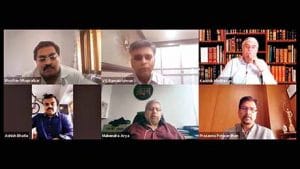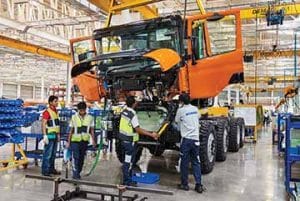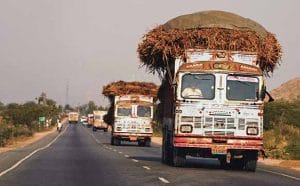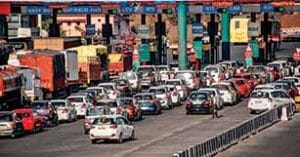CV utilisation is going up and manufacturers of trucks and buses are hoping for growth to return quickly.
Story by Deven Lad
Shifting gears the CV industry is. It did so during the two months of lockdown due to Covid-19 in India, and albeit at a much slower rate. If Ashok Leyland launched its AVTR range of modern, modular and BSVI medium and heavy-duty trucks during the lockdown, the road freight (transport) fraternity, as well as the private bus operators, rose to demand relief in taxes and protection for their drivers in what is looked upon as a rare show of unity. If the two developments marked a silver lining, it would be too early to conclude. Of the opinion that the CV industry is in a good zone, VG Ramakrishnan, MD & Managing Partner at Avanteum Advisors LLP, mentioned that the challenges faced by it are largely global rather than local. Pointing at how the economy and CV industry are closely related, he expressed that industry-specific issues have turned into national issues. “The supply chain is currently the area of focus”, he added.
Calling for GST reduction, scrappage policy with an attractive incentive, and the availability of liquidity, Ramakrishnan averred that he saw opportunities for the Indian CV industry growing in international markets. “Since the CV industry has moved to BSVI, it now has an opportunity to enter advanced markets,” he remarked. Stating that companies with lower cash flow would struggle to survive, Ramakrishnan called upon the CV industry to cut down on non-value-added costs to deal with the current situation better. “If one could survive the next two years, it could survive in the business for a long, long time,” he said. Echoing Ramakrishnan’s sentiments, Kaushik Madhavan, Vice President — Mobility, Frost & Sullivan, stated that there could be 35 per cent degrowth (due to the Covid-19 situation). He informed further, “Any recovery or upward swing would be seen in 2022 or next year at the earliest.”
Setting the cogs
Touching on how the components industry in India is adapting to the change brought about by Covid-19 especially, and the new normal that is said to be in the making, Madhavan stated that survival is key to small scale vendors and suppliers today. It is important, he said. Of the opinion that OEMs could lend financial support to its vendors and suppliers so that they could survive, Madhavan stressed on diversification of supplier strategy as the key. “A strategy to consolidate on the supplier and vendor side is the key,” he announced. Touching on long term perspectives, investment in predictive maintenance, diagnostics and prognostics, Madhavan expressed that digitisation and development of vendors would be of utmost importance in the long term. He added, “The stimulus package reaching two- and three-tier component manufacturers is a bit of a chicken and egg situation.”
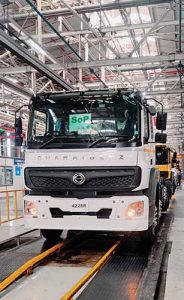 Explaining that it would be tough to determine if the stimulus package would reach them first or they would start coming up on their own first, Madhavan said, “The transition from mechanical engineering to mechatronic engineering will be crucial.” Stressing on the need for MSME component manufacturers to transition from mechanical goods manufacturing to mechatronic goods manufacturing in-line with the global engineering developments, Madhavan mentioned that this would also provide an opportunity for such enterprises to de-risk. Of the opinion that doing so will also help them build new capabilities, Madhavan expressed, “The move to mechatronics would also open the door to many other opportunities to diversify, stay relevant and competitive.” Averred Ramakrishnan, “Structural inefficiency across the value chain could be a hurdle.” He drew attention to cash flow challenges in the current situation.
Explaining that it would be tough to determine if the stimulus package would reach them first or they would start coming up on their own first, Madhavan said, “The transition from mechanical engineering to mechatronic engineering will be crucial.” Stressing on the need for MSME component manufacturers to transition from mechanical goods manufacturing to mechatronic goods manufacturing in-line with the global engineering developments, Madhavan mentioned that this would also provide an opportunity for such enterprises to de-risk. Of the opinion that doing so will also help them build new capabilities, Madhavan expressed, “The move to mechatronics would also open the door to many other opportunities to diversify, stay relevant and competitive.” Averred Ramakrishnan, “Structural inefficiency across the value chain could be a hurdle.” He drew attention to cash flow challenges in the current situation.
Need for tax structure improvement
Stressing on the fight to survive, Ramakrishnan explained that India needs to improve the tax structure if it were to compete globally. If the tax structure was right, a massive opportunity for the supply chain could be unleashed, he added. Bringing up the supply chain and road freight (transport) side of the CV industry, Mahendra Arya, President, All India Transport Workers’ Association (AITWA), expressed that there was a need to look at the complete situation from a supply chain perspective. “The government’s Rs.20 lakh crore (stimulus) package has not provided any relief to the transportation industry,” he said. Informing that bigger fleets do not have more than 15 per cent vehicles of their own, Arya averred that it were the smaller operators that needed to be supported at this moment in time. On the topic of the steep rise in diesel prices, Arya said that there has been no roll-back in fuel prices if one were to look back 30 years. “It would therefore be prudent to look at more pressing matters at this moment,” he added.
Informing that nearly 95 per cent of the bus industry has been under lockdown for the last three months, Prasanna Patwardhan, President, Bus Operators Confederation of India (BOCI), said that the Rs.20 lakh crore (stimulus) package has been of no help to the bus industry either. Announcing that not more than five per cent of buses are plying on roads, Patwardhan mentioned, “Many state governments are not giving tax waivers.” Both, the public and private operators are in a difficult situation, he informed. Drawing attention to the fact that 90 per cent people use public transport and are dependant on it, Patwardhan explained that STUs are bleeding heavily. The private ones are barely surviving, he added. Revealing that his association has requested the Government of Maharashtra to look at their situation and provide relief, Patwardhan said that it is ironic that tax on public transport in India is the highest. “Globally,” he stated, “there is no tax on public transport.”
Demanding tax relief and the provision of diesel at concessional rate (the government recently hiked diesel prices by a steep Rs.10 per litre), Patwardhan also called for banks to waive off interest for the period when the bus industry did not conduct any business. Stressing on extending insurance policies, he mentioned that the least that could be done was to not increase the premium for the last two years.
Stating that every minister should be assigned the role of reaching out to their subjects and understand as well as address their issues, Arya said that the government has to play its role. It has to provide the necessary relief. Stressed, Ramakrishnan, on the need to redefine the value chain. He also called for the need to transform business models and for every association and industry to contribute to the Atma Nirbhar Bharat program. Pointing at the moratorium offered by banks, Madhavan said that the difference between what the Reserve Bank of India(RBI) has recommended and what the interstate banks are providing is huge. “There has to be some reconciliation between the two,” he averred.
The ghost of motor insurance and toll tax
Stressing on insurance regulatory authority steadily increasing the basic insurance premium on vehicles by no less than 30 to 40 per cent for the last few years, an industry analyst, on the condition of not revealing his name, mentioned that it has already reached near unsustainable levels. Any increase, and it will turn out to be the last straw on the camel’s back, at least for the truck and bus industry, he added. Drawing attention to the change of rules in 2018 that drove the insurance costs by a significant margin, the analyst mentioned that it is high time that policies are closely linked with vehicle usage to ensure their effectiveness. Especially those of CVs.
The other subject that the analyst spoke about was road toll tax. Stating that such a phenomenon was rare even in advanced countries like England, and was linked in a transparent manner with the quality of infrastructure provided, he said that the steep rise in toll here is unfortunate. It is unfortunate that vehicles pay road tax upfront for their life and pay toll tax as well for almost every stretch of road that they use. Then, there are road taxes charged by local authorities as well under one pretext or the other. Even villages levy road tax for passage of vehicles which is very absurd, he expressed. For CV operators, this has been a matter of headache and unaccounted for costs, he informed. It often comes with harassment, delays, and material as well as human loss. The constant rise in their prices is something that points at the development of quasi-judicial powers, which is not good for the nation, he added.



